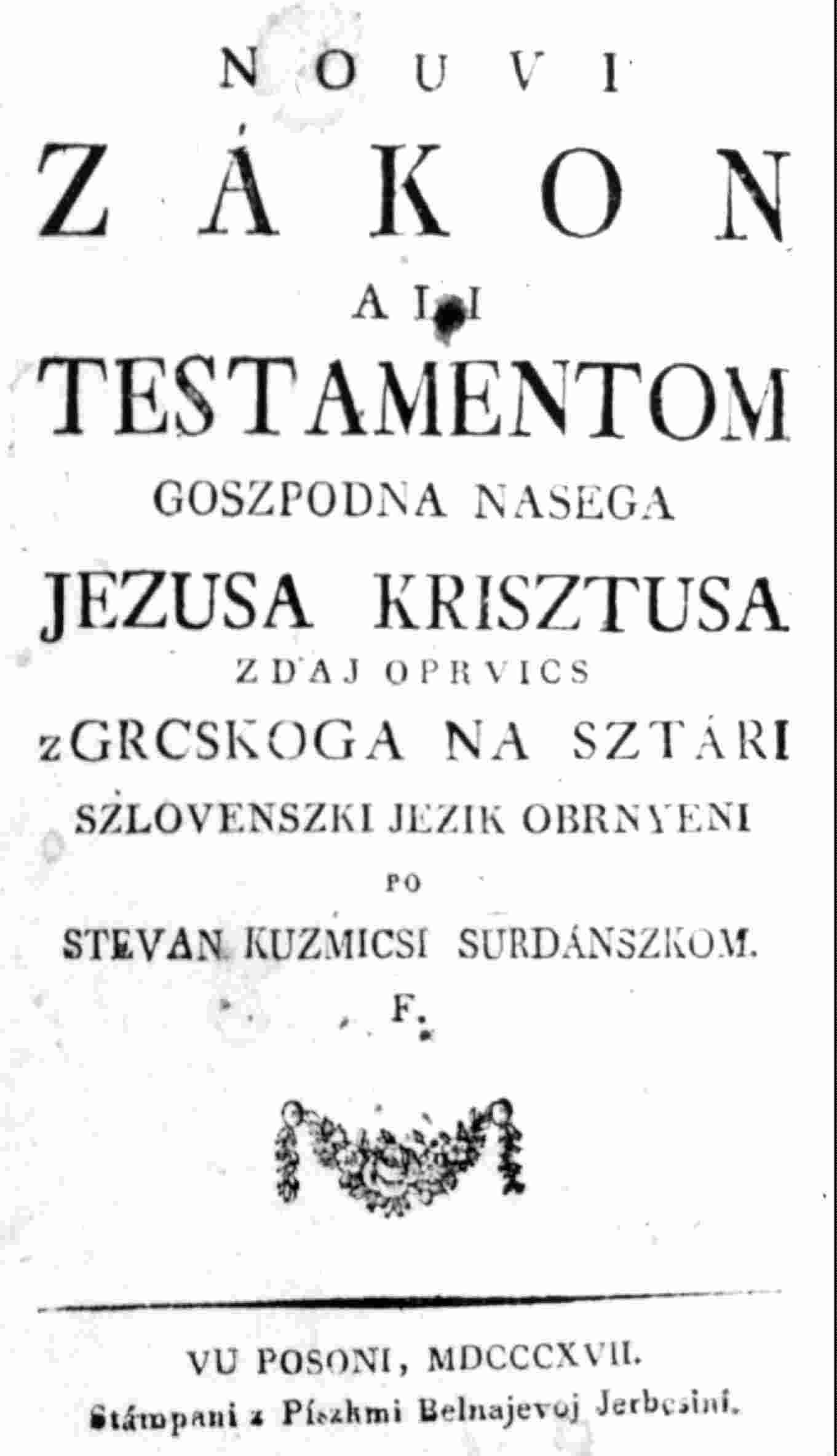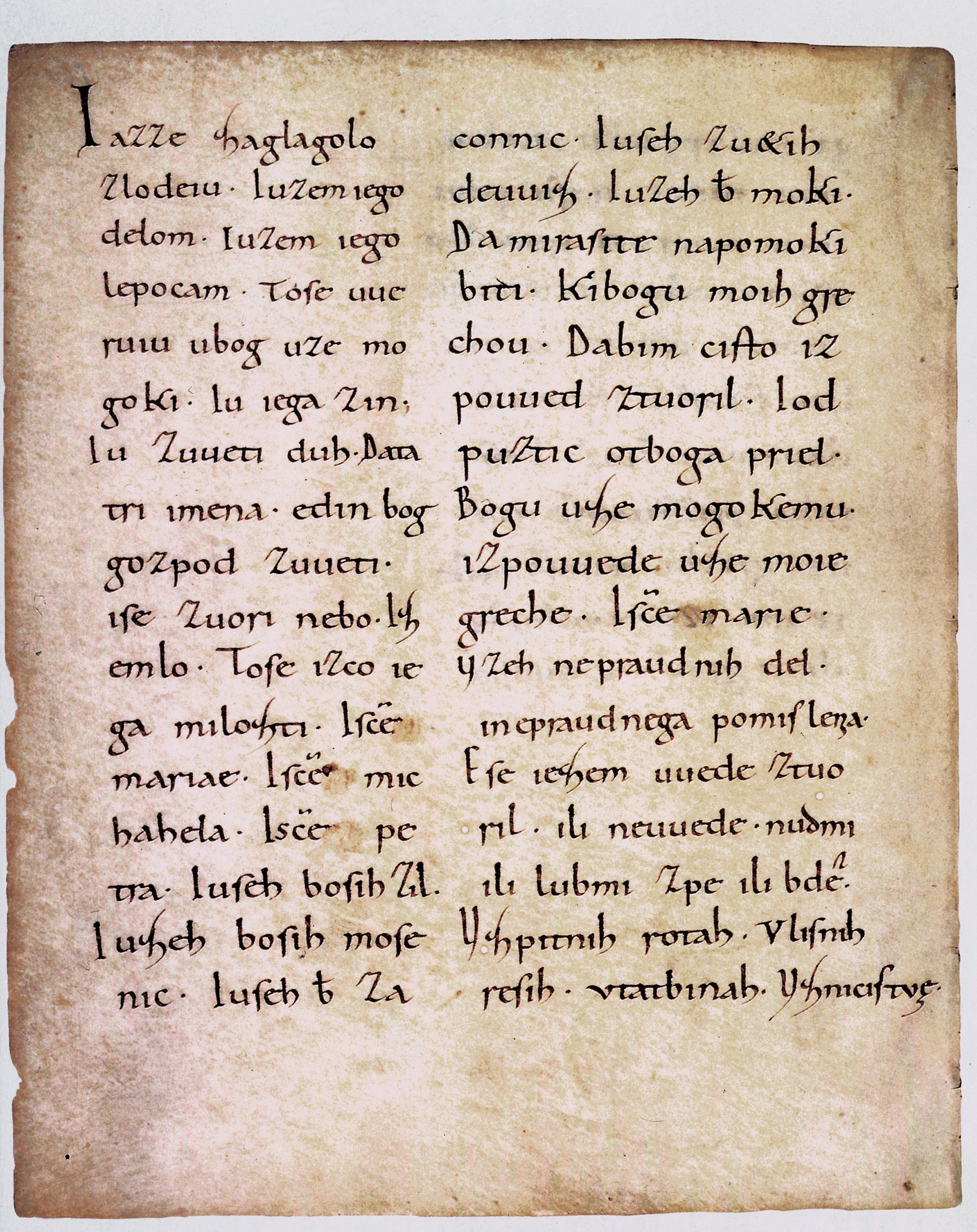|
Nouvi Zákon
''Nouvi Zákon'' (New Testament) is the best-known work of the Hungarian Slovene writer István Küzmics. ''Nouvi Zákon'' is a translation of the New Testament into the Prekmurje Slovene dialect. This text and Miklós Küzmics's ''Szvéti Evangyeliomi'' are the most important works in standard Prekmurje Slovene. The prologue ''(Predgovor)'' Küzmics published ''Nouvi Zákon'' in 1771 in Halle, Saxony-Anhalt, with the assistance of Hungarian and Slovene Lutherans ''(Nouvi Zákon ali Testamentim Goszpodna Nasega Jezusa Krisztusa zdaj oprvics zGrcskoga na sztári szlovenszki jezik obrnyeni po Stevan Küzmicsi Surdánszkom f.)''. There is dispute as to whether the prologue ''(Predgovor),'' was written by Küzmics or by some other person. One other possible author is the Hungarian Lutheran pastor József Torkos. Torkos evidently wrote the prologue in Latin and Küzmics in turn translated it into the Prekmurje dialect. This question was raised by the Slovene writer Mihály Bakos, w ... [...More Info...] [...Related Items...] OR: [Wikipedia] [Google] [Baidu] |
Prekmurje
Prekmurje (; dialectically: ''Prèkmürsko'' or ''Prèkmüre''; hu, Muravidék) is a geographically, linguistically, culturally and ethnically defined region of Slovenia, settled by Slovenes and a Hungarian minority, lying between the Mur River in Slovenia and the Rába Valley (the watershed of the Rába; sl, Porabje) in the westernmost part of Hungary. It maintains certain specific linguistic, cultural and religious features that differentiate it from other Slovenian traditional regions. It covers an area of and has a population of 78,000 people. Name It is named after the Mur River, which separates it from the rest of Slovenia (a literal translation from Slovene would be ''Over-Mur'' or ''Transmurania''). In Hungarian, the region is known as ''Muravidék'', and in German as ''Übermurgebiet''. The name Prekmurje was introduced in the twentieth century, although it is derived from an older term. Before 1919, the Slovenian-inhabited lands of Vas County in the Kingdom ... [...More Info...] [...Related Items...] OR: [Wikipedia] [Google] [Baidu] |
Vienna
en, Viennese , iso_code = AT-9 , registration_plate = W , postal_code_type = Postal code , postal_code = , timezone = CET , utc_offset = +1 , timezone_DST = CEST , utc_offset_DST = +2 , blank_name = Vehicle registration , blank_info = W , blank1_name = GDP , blank1_info = € 96.5 billion (2020) , blank2_name = GDP per capita , blank2_info = € 50,400 (2020) , blank_name_sec1 = HDI (2019) , blank_info_sec1 = 0.947 · 1st of 9 , blank3_name = Seats in the Federal Council , blank3_info = , blank_name_sec2 = GeoTLD , blank_info_sec2 = .wien , website = , footnotes = , image_blank_emblem = Wien logo.svg , blank_emblem_size = Vienna ( ; german: Wien ; ba ... [...More Info...] [...Related Items...] OR: [Wikipedia] [Google] [Baidu] |
Sándor Terplán
Sándor Terplán ( sl, Aleksander Terplan or ''Trpljan'') (c. May 1, 1816 – March 18, 1858) was a Hungarian Lutheran priest and writer. Terplán was born in the Ivanovci in the Prekmurje region in the Kingdom of Hungary, into a Hungarian Slovene Lutheran family. Several priests were born in his village, both Catholic and Lutheran, including littérateurs or gentilitial politicians, such as József Borovnják and Ferenc Ivanóczy. Terplán's father Iván Terplan was a tailor and wine-merchant and estate manager of Baron Szaller in Ivanovci. His mother Zsuzsanna Berke was the aunt of writer Iván Berke and she was from noble family. Sándor Terplan studied in the elementary schools of Domanjševci and Szentgyörgyvölgy, in the Őrség region. From 1828 he studied in Kőszeg and also in Sopron, where he studied theology. In 1837 he got a scholarship and went to Vienna. He started working as a chaplain in Puconci, near Murska Sobota. Later he lived in Szombathely, but i ... [...More Info...] [...Related Items...] OR: [Wikipedia] [Google] [Baidu] |
Kőszeg
Kőszeg (german: Güns, ; Slovak: ''Kysak'', sl, Kiseg, hr, Kiseg) is a town in Vas County, Hungary. The town is famous for its historical character. History The origins of the only free royal town in the historical garrison county of Vas (Eisenburg) go back to the third quarter of the thirteenth century. It was founded by the Kőszegi family, a branch of the Héder clan, who had settled in Hungary in 1157 AD. Sometime before 1274 Henry I and his son Ivan moved the court of the Kőszegi, a breakaway branch of the family, from Güssing to Kőszeg (Güns). For decades, the town was the seat of the lords of Kőszeg (Güns). Only in 1327 did Charles Robert of Anjou finally break the power of the Kőszegi family in Western Transdanubia, and a year later, in (1328), elevated the town to royal status. The town boundaries were fixed during the Anjou dynasty (1347–1381). In 1392 the royal town became a fiefdom, when the Palatinate Nicolas Garai repaid a bond paid to King Sigi ... [...More Info...] [...Related Items...] OR: [Wikipedia] [Google] [Baidu] |
Bratislava
Bratislava (, also ; ; german: Preßburg/Pressburg ; hu, Pozsony) is the Capital city, capital and largest city of Slovakia. Officially, the population of the city is about 475,000; however, it is estimated to be more than 660,000 — approximately 140% of the official figures. Bratislava is in southwestern Slovakia at the foot of the Little Carpathians, occupying both banks of the River Danube and the left bank of the Morava (river), River Morava. Bordering Austria and Hungary, it is the only national capital that borders two sovereign states. The city's history has been influenced by people of many nations and religions, including Austrians, Bulgarians, Croats, Czechs, Germans, Hungarian people, Hungarians, Jews, Romani people, Romani, Serbs and Slovaks. It was the coronation site and legislative center and capital of the Kingdom of Hungary from 1536 to 1783; eleven King of Hungary, Hungarian kings and eight queens were crowned in St Martin's Cathedral, Bratislava, St Martin' ... [...More Info...] [...Related Items...] OR: [Wikipedia] [Google] [Baidu] |
South Slavs
South Slavs are Slavic peoples who speak South Slavic languages and inhabit a contiguous region of Southeast Europe comprising the eastern Alps and the Balkan Peninsula. Geographically separated from the West Slavs and East Slavs by Austria, Hungary, Romania, and the Black Sea, the South Slavs today include Bosniaks, Bulgarians, Croats, Macedonians, Montenegrins, Serbs, and Slovenes, respectively the main populations of Bosnia and Herzegovina, Bulgaria, Croatia, North Macedonia, Montenegro, Serbia, and Slovenia. In the 20th century, the country of Yugoslavia (from Serbo-Croatian, literally meaning "South Slavia" or "South Slavdom") united majority of South Slavic peoples and lands—with the exception of Bulgarians and Bulgaria—into a single state. The Pan-Slavic concept of ''Yugoslavia'' emerged in the late 17th century Croatia, at the time party of Habsburg Monarchy, and gained prominence through the 19th-century Illyrian movement. The Kingdom of Serbs, Croats and Slovenes ... [...More Info...] [...Related Items...] OR: [Wikipedia] [Google] [Baidu] |
Slovene Literature
Slovene literature is the literature written in Slovene. It spans across all literary genres with historically the Slovene historical fiction as the most widespread Slovene fiction genre. The Romantic 19th-century epic poetry written by the leading name of the Slovene literary canon, France Prešeren, inspired virtually all subsequent Slovene literature. Literature played an important role in the development and preservation of the Slovene identity because the Slovene nation did not have its own state until 1991 after the Republic of Slovenia emerged from the breakup of Yugoslavia. Poetry, narrative prose, drama, essay, and criticism kept the Slovene language and culture alive, allowing - in the words of Anton Slodnjak - the Slovenes to become a real nation, particularly in the absence of masculine attributes such as political power and authority. Early literature There are accounts that cite the existence of an oral literary tradition that preceded the Slovene written lit ... [...More Info...] [...Related Items...] OR: [Wikipedia] [Google] [Baidu] |
József Borovnyák
József Borovnyák or Borovnják ( sl, Jožef Borovnjak; 1826 – 19 September 1909) was a Prekmurje Slovene writer, politician, and Roman Catholic priest in Hungary. Borovnják was born in the village of Ivanócz (later Alsószentbenedek, Slovenian Ivanovci). His family was originally Protestant. His father converted to Catholicism. Borovnják first served as a priest from 1851 to 1852 at the Istvánfalvian Church in the village of Apátistvánfalva ( Vas Country). He was later a priest in Felsőlendva and Cankova (where he died). Borovnják was a defender of the local Prekmurje dialect. He wrote books in it; for example, a catechism and prayer books. In 1877 he posthumously reprinted Miklós Küzmics' Prekmurje dialect translation of the gospels. He was also involved in politics. Works * ''Jezus moje poslenje'' (Jesus Is My Desire), * ''Veliki katekizmus'' (Large Catechism) * ''Kniga molitvena sztara szlovenszka'' (Old Slovene Prayer Book) * ''Dühovna hrána'' (T ... [...More Info...] [...Related Items...] OR: [Wikipedia] [Google] [Baidu] |
Szvéti Evangyeliomi
Szvéti evangyeliomi (''The Holy Gospels''), later Szvéti evangeliomi, is the first Catholic translation of the Bible into Prekmurje Slovene. It was written by Miklós Küzmics (1737–1804), the dean of Prekmurje and the Rába Valley. The publication in 1780 was financed by János Szily, the first bishop of Szombathely. ''Szvéti evangyéliomi'' had a significant role in the formation of standard Prekmurje Slovene. It was a standard for numerous works published in Prekmurje from 1780 until 1920. Küzmics began his work in 1763. However, he did not receive support from the bishop of Győr. When István Küzmics's Protestant translation, ''Nouvi Zákon'', was published, he was greatly disappointed. Slovene Catholics had to read Protestant books because they did not have their own. Küzmics called for bishops to take action against the "heretical" New Testament. For a long time it was thought that Küzmics had copied his text from ''Nouvi Zákon''. However, despite some sim ... [...More Info...] [...Related Items...] OR: [Wikipedia] [Google] [Baidu] |
Roman Catholic Church
The Catholic Church, also known as the Roman Catholic Church, is the largest Christian church, with 1.3 billion baptized Catholics worldwide . It is among the world's oldest and largest international institutions, and has played a prominent role in the history and development of Western civilization.O'Collins, p. v (preface). The church consists of 24 ''sui iuris'' churches, including the Latin Church and 23 Eastern Catholic Churches, which comprise almost 3,500 dioceses and eparchies located around the world. The pope, who is the bishop of Rome, is the chief pastor of the church. The bishopric of Rome, known as the Holy See, is the central governing authority of the church. The administrative body of the Holy See, the Roman Curia, has its principal offices in Vatican City, a small enclave of the Italian city of Rome, of which the pope is head of state. The core beliefs of Catholicism are found in the Nicene Creed. The Catholic Church teaches that it is th ... [...More Info...] [...Related Items...] OR: [Wikipedia] [Google] [Baidu] |
Middle Ages
In the history of Europe, the Middle Ages or medieval period lasted approximately from the late 5th to the late 15th centuries, similar to the post-classical period of global history. It began with the fall of the Western Roman Empire and transitioned into the Renaissance and the Age of Discovery. The Middle Ages is the middle period of the three traditional divisions of Western history: classical antiquity, the medieval period, and the modern period. The medieval period is itself subdivided into the Early, High, and Late Middle Ages. Population decline, counterurbanisation, the collapse of centralized authority, invasions, and mass migrations of tribes, which had begun in late antiquity, continued into the Early Middle Ages. The large-scale movements of the Migration Period, including various Germanic peoples, formed new kingdoms in what remained of the Western Roman Empire. In the 7th century, North Africa and the Middle East—most recently part of the Eastern Ro ... [...More Info...] [...Related Items...] OR: [Wikipedia] [Google] [Baidu] |





.jpg)
